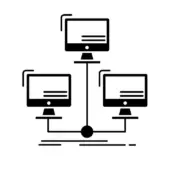Most designers have a strong idea of the functions and features they want their products to include. However, starting the design process without doing UX research is much like building a home without architectural plans. UX research forms the foundation of your entire design process.
This research, including aspects such as user behavior, preferences, and pain points, helps you gain an understanding of your market, target audience, and competition through in-depth data analysis. Without it, you risk creating products that don’t cater to user needs or stand out from competitors—or that simply have no demand in the market.
In this guide, we’ll help you determine the best research strategies for your unique project. We’ll also look at key UX research methods to generate actionable insights for design success.

Types of UX Research Methods
Your methods guide your research, so choosing the right strategy from the start will help you generate the most relevant UX insights for your specific project. Combining quantitative and qualitative research methods can provide the most holistic view of your product or service from the consumers’ perspective.
UpTop Perspective
Research is a scoping exercise. When you do research upfront, you find the real problem, and solutions become clear. This allows the ideation phase to decrease because the problem is identified earlier in the process, so you can create more focus and reduce features.
The following UX research methods are some of the most effective and accurate ways to obtain valuable data for superior product design.
1. User Persona Development and Their Role
Also referred to as model characters, personas help bring a human touch to research data. Researchers create personas that depict typical or atypical (extreme) users according to collected data. These personas provide an understanding of user needs, goals, motivations, and behaviors; which aid in designing for specific types of users.
Best Practices for Creating Personas
- Collect relevant information about your target users through interviews, surveys, analytics, and observation.
- Segment users by identifying common characteristics, behaviors, and goals. Each segment should represent a distinct user type with unique needs and preferences.
- Assign names and images to your personas. This helps the design team to empathize and keep the personas top of mind during the design process.
- Include essential details about each persona, such as demographics, goals, frustrations, and behaviors.
- Prioritize primary personas that clearly embody your core target group.
- Regularly review and update personas based on new research findings and user feedback.
2. Conducting User Interviews
User interviews involve direct conversations with users to gather data about their experiences, inclinations, habits, and desires. These interviews provide valuable insights and perspectives that may not be apparent via other research methods.
Best Practices for Conducting User Interviews
- Define your research goals—and stay focused on these outcomes.
- Select participants who represent your target user group and include a diverse range of backgrounds, experiences, and perspectives.
- Develop a set of open-ended questions, avoiding leading or biased questions.
- Use probing techniques. Ask follow-up questions to gain a deeper understanding of participants’ responses.

3. Usability Testing
Usability testing entails observing users interacting with the product and collecting qualitative and quantitative data to identify issues and opportunities for improvement. This is a crucial UX research method, used to evaluate the experience of a product or prototype. Early identification and resolution of issues will reduce the financial and timeline costs of redesigning and reprogramming later.
During a test, researchers will:
- Assess if participants can complete tasks successfully
- Measure task completion time
- Measure user satisfaction
- Identify changes needed to improve performance and satisfaction
- Analyze performance to determine if objectives are met
4. Accessibility Testing
While usability testing focuses on overall user experience, accessibility testing zooms in on equal access for those with disabilities, evaluating the features and functionalities of a product to ensure ease of use. In addition, it evaluates compliance with legal requirements and standards like Web Content Accessibility Guidelines (WCAG).
Accessibility testing typically requires specialized knowledge of accessibility parameters, assistive technologies, and the needs of individuals with disabilities. This enables accurate identification of barriers that may prevent effective product use.

5. User Surveys and Questionnaires
Surveys and questionnaires are popular UX research methods because they’re cost-effective, easy to administer, and can reach an expansive audience. They provide a structured approach for gathering feedback and can be administered through various channels, such as online forms, email, or in-app prompts.
Surveys and questionnaires consist of carefully crafted questions designed to gather specific information. These questions can come in the form of multiple-choice, Likert scale, ranking, open-ended, or a combination of different types of questions. The type of question you choose depends on your research goals.
Best Practices for Conducting Surveys
- Ensure the sample selection is representative of your actual users or target users.
- Create questions that are easy to understand. Avoid jargon or ambiguous terms.
- Ensure questions address your research objective.
- Use a consistent format with clear instructions.
- Avoid leading or biased questions.
- Use tools and techniques to identify patterns, trends, and correlations in the data obtained.
Surveys don’t always capture the full context or rich insights of other methods. Therefore, you’ll want to supplement survey data with other UX research methods for a more comprehensive understanding.

6. Analytics and User Behavior Tracking
When it comes to tracking user behavior, website analytics proves to be an indispensable tool. Tracking user interactions—such as page views, click-through rates, time spent on pages, and conversions—shows how users interact with a product or website.
Researchers can collect this data via user research panels, session recording tools, eye tracking, heat maps, or mouse tracking. Segmenting the data based on various criteria, such as demographics, device types, geographic location, or user characteristics, can help you further dial in on user experience and behavior.
Some helpful engagement metrics to assess include the time spent on a page, scroll depth, or number of interactions per session. Likewise, track key performance indicators (KPIs) such as conversion rate, bounce rate, click-through rate (CTR), churn, error rates, and task success.
UpTop Perspective
Session recordings, click and error tracking, funnel analysis provide a more granular and visual view of user behavior to help you understand the ‘why’ behind the data collected by traditional analytics tools
7. Competitive Analysis
Do not forget to evaluate and compare your product or service’s user experience with its competitors. This analysis will help you gain a better understanding of your market landscape, industry trends, and areas for improvement, supporting the creation of a more competitive and user-centered product.
Methods for analyzing the competition include:
- Conducting a SWOT analysis on a specific competitor or product.
- Using a competitor’s product to analyze competitor touchpoints, app and website experience, product quality, and pricing.
- Reading competitors’ reviews. This can help you gain insights into what consumers love about your competitors and things that frustrate them.
- Comparing your user journey to successful competitors. Evaluate key differences that may count to their advantage, such as strategic CTA placement or fewer steps to convert customers.
Backup Your Product Design With Real Data
UX research provides the data you need to prove the validity of and need for your concept.
At UpTop, our UX strategy, product design, and software development teams assist businesses to seize market opportunities and expand their reach by facilitating the creation of exceptional digital experiences. Our experts collaborate with you to provide direction for design decisions from the start and utilize strategic research to validate those decisions.
By conducting UX research and understanding consumer psychology from day one, you can optimize your product for maximum conversions and retention. Chat with us today for a customized research and implementation solution.



